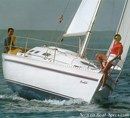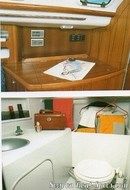Gib'Sea 302 Deep draft
Sailboat specifications
The Gib'Sea 302 is a 29’5” (8.95m) cruising sailboat designed by Joubert Nivelt Design (France). She was built between 1992 and 1996 by Gibert Marine (France) with 145 hulls completed. The Deep draft version offers a deeper L-shaped keel bringing extra performance especially upwind.
Gib'Sea 302's main features
- Model
- Gib'Sea 302
- Version
- Deep draft
- Hull type
- Monohull
- Category
- Cruising sailboat
- Sailboat builder
- Sailboat designer
- Sailboat range
- Country
- France
- Construction
- GRP (glass reinforced polyester):
- Hull: Single skin fiberglass polyester
- Deck: Sandwich fiberglass polyester - Number of hulls built
- 145
- First built hull
- 1992
- Last built hull
- 1996
- Appendages
- Keel : L-shaped keel (with bulb)
- Helm
- Single tiller
- Rudder
- Single spade rudder
- Unsinkable
- No
- Trailerable
- No
- Former French navigation category
- 2
- Standard public price ex. VAT (indicative only)
- N/A €
Gib'Sea 302's main dimensions
- Hull length
- 29’ 5”8.95 m
- Waterline length
- 25’ 7”7.8 m
- Beam (width)
- 11’3.34 m
- Draft
- 6’1.83 m
- Mast height from DWL
- 46’ 7”14.2 m
- Fore freeboard
- 3’ 8”1.14 m
- Mid-ship freeboard
- 3’ 1”0.96 m
- Light displacement (MLC)
- 7055 lb3200 kg
- Ballast weight
- 2425 lb1100 kg
- Ballast type
- Cast iron
- French customs tonnage
- 7.97 Tx
Gib'Sea 302's rig and sails
- Upwind sail area
- 558 ft²51.8 m²
- Downwind sail area
- 894 ft²83.1 m²
- Mainsail area
- 254 ft²23.6 m²
- Genoa area
- 304 ft²28.2 m²
- Symmetric spinnaker area
- 640 ft²59.5 m²
- IiFore triangle height (from mast foot to fore stay top attachment)
- 37’ 10”11.52 m
- JiFore triangle base (from mast foot to bottom of forestay)
- 10’ 8”3.25 m
- PiMainsail hoist measurement (from tack to head)
- 35’ 10”10.9 m
- EiMainsail foot measurement (from tack to clew)
- 12’ 10”3.9 m
- Rigging type
- Sloop Marconi 9/10
- Mast configuration
- Deck stepped mast
- Rotating spars
- No
- Number of levels of spreaders
- 2
- Spreaders angle
- Swept-back
- Spars construction
- Aluminum spars
Gib'Sea 302's performances
- HN (French rating)iHN or "Handicap Nationale" is an empirical rating system used in France allowing various monohulls, of different sizes and designs, to race each other fairly. It is particularly suitable for cruiser and cruiser-racer. Therefore, by comparing these values, we can have an indication of the relative speed of 2 boats.
- 20.0
- Upwind sail area to displacementiThe ratio sail area to displacement is obtained by dividing the sail area by the boat's displaced volume to the power two-thirds.
The ratio sail area to displacement can be used to compare the relative sail plan of different sailboats no matter what their size.
Upwind: under 18 the ratio indicates a cruise oriented sailboat with limited performances especially in light wind, while over 25 it indicates a fast sailboat. - 257 ft²/T23.85 m²/T
- Downwind sail area to displacementiThe ratio sail area to displacement is obtained by dividing the sail area by the boat's displaced volume to the power two-thirds.
The ratio sail area to displacement can be used to compare the relative sail plan of different sailboats no matter what their size. - 412 ft²/T38.27 m²/T
- Displacement-length ratio (DLR)iThe Displacement Length Ratio (DLR) is a figure that points out the boat's weight compared to its waterline length. The DLR is obtained by dividing the boat's displacement in tons by the cube of one one-hundredth of the waterline length (in feet).
The DLR can be used to compare the relative mass of different sailboats no matter what their length:
a DLR less than 180 is indicative of a really light sailboat (race boat made for planning), while a DLR greater than 300 is indicative of a heavy cruising sailboat. - 191
- Ballast ratioiThe Ballast ratio is an indicator of stability; it is obtained by dividing the boat's displacement by the mass of the ballast. Since the stability depends also of the hull shapes and the position of the center of gravity, only the boats with similar ballast arrangements and hull shapes should be compared.
The higher the ballast ratio is, the greater is the stability. - 34 %
- Critical hull speediAs a ship moves in the water, it creates standing waves that oppose its movement. This effect increases dramatically the resistance when the boat reaches a speed-length ratio (speed-length ratio is the ratio between the speed in knots and the square root of the waterline length in feet) of about 1.2 (corresponding to a Froude Number of 0.35) . This very sharp rise in resistance, between speed-length ratio of 1.2 to 1.5, is insurmountable for heavy sailboats and so becomes an apparent barrier. This leads to the concept of "hull speed".
The hull speed is obtained by multiplying the square root of the waterline length (in feet) by 1.34. - 6.78 knots
Gib'Sea 302's auxiliary engine
- Engine(s)
- 1 inboard engine
- Engine(s) power
- 18 HP
- Fuel type
- Diesel
- Fuel tank capacity
- 15.9 gal60 liters
Gib'Sea 302's accommodations and layout
- Cockpit
- Closed aft cockpit
- Cabin(s)
- 2
- Berth(s) (min./max.)
- 4 / 6
- Head(s)
- 1
- Freshwater tank capacity
- 47.6 gal180 liters


Gibert Marine Gib'Sea 302 - - 1/6
Picture extracted from the commercial documentation © Gibert Marine
Picture extracted from the commercial documentation © Gibert Marine


Gibert Marine Gib'Sea 302 sailplan - - 2/6
Picture extracted from the commercial documentation © Gibert Marine
Picture extracted from the commercial documentation © Gibert Marine


Gibert Marine Gib'Sea 302 sailing - - 3/6
Picture extracted from the commercial documentation © Gibert Marine
Picture extracted from the commercial documentation © Gibert Marine


Gibert Marine Gib'Sea 302 sailing - - 4/6
Picture extracted from the commercial documentation © Gibert Marine
Picture extracted from the commercial documentation © Gibert Marine


Gibert Marine Gib'Sea 302 interior and accommodations - - 5/6
Picture extracted from the commercial documentation © Gibert Marine
Picture extracted from the commercial documentation © Gibert Marine


Gibert Marine Gib'Sea 302 interior and accommodations - - 6/6
Picture extracted from the commercial documentation © Gibert Marine
Picture extracted from the commercial documentation © Gibert Marine
Similar sailboats that may interest you:
Sailboats
First built hull
Hull length
1987
31’ 4”9.55 m
2019
29’ 6”8.99 m
1983
30’ 2”9.2 m
1997
27’ 11”8.5 m
2005
31’9.45 m
2008
28’ 10”8.79 m
2008
32’9.74 m
1983
31’ 10”9.7 m
2007
30’ 6”9.3 m
2003
32’9.75 m
1984
29’ 8”9.05 m
1997
31’ 2”9.5 m
1995
29’ 4”8.92 m
2003
32’9.75 m
1996
29’ 5”8.95 m